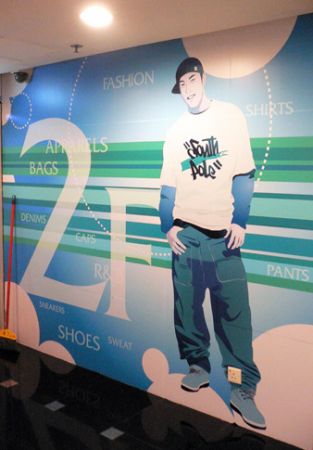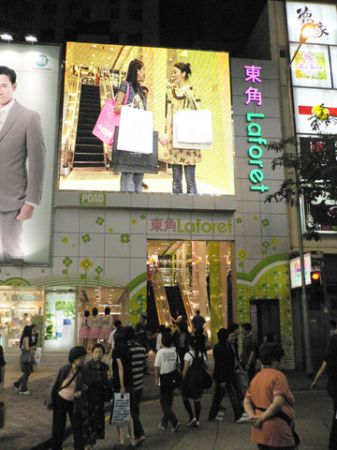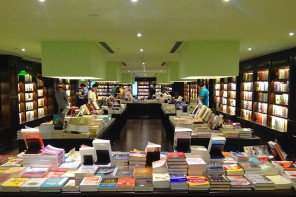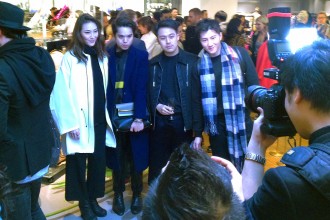From Mongkok to Tsim Sha Tsui, all the way to Causeway Bay, mini-malls have made a massive comeback around town. When I say mini-malls, I’m talking about floors of a building that have been divided into small, compartmentalized shops. A typical mini-mall will hold dozens of these small stores, many of them the size of walk-in closets!
The recent boom is partially due to the steady increase in rents. Hong Kong is already one of the top three most expensive cities in the world. Renting a shop on the ground floor in any of these three prime neighborhoods is astronomical, and a guaranteed money-loser for all but the most savvy businesses. The turnover rate needed to achieve a profit is extremely high.
[photopress:Red_Trendy_Mall_Causeway_Ba.jpg,full,pp_image]The new mini-malls have been taking root in spaces formerly occupied by large restaurants, banquet halls, and movie theaters. These businesses were often in place for years, when the rents were cheaper and the earning-per-square-foot required was at a much lower level. With the new ratios, their earnings just can’t sustain the hike in rents.
A savvy, money-saving technique on the part of mini-mall developers is to open in either basements or on higher floors of a building. The ground-level entrance-ways for mini-malls are often simply an over-decorated escalator or stairwell leading to the first floor of shops.
[photopress:Mini_Mall_Trendy_graphic_HK.jpg,full,pp_image]Normally these mini-malls feature flashy designs aimed at appearing young and hip, The names are also carefully chosen to give them a cool edge. Some clearly try to appeal to a particular gender.
[photopress:Red_Mall_Causeway_Bay_HK.jpg,full,pp_image] [photopress:Red_Mall_sign_Causeway_Bay.jpg,full,pp_image] [photopress:Chic_trendy_mall_Mongkok.jpg,full,pp_image]Mini-malls play an important part in Hong Kong’s fashion scene. Due to the small nature of the spaces, they allow people to sell their products to the public without the commitment of a large and costly store. Going into business therefore has a much lower barrier to entry than in the U.S. or Europe. This is good for shoppers, but bad for small businesses, who must compete with these tiny shops (with much lower overhead,) on price.
One of the pioneer malls of this type was the Rise Commercial Building in Tsim Sha Tsui. It opened in the late 90’s and held a number of local designers as well as people who imported new styles from Japan and re-sold them to trend-conscious H.K. shoppers. In places like Rise, people open shops on the side, so business hours can sometimes be erratic. Many of the shops don’t open until the late afternoon and may close at around 11 pm.
During S.A.R.S. Hong Kong’s mini-malls took a huge hit, and a stroll through them was like a walk through a ghost town. They have only just started to thrive again.
Actor, director, and business man, Stephen Chow Sing-chi recently opened a new mini-mall on Granville Road in Tsim Sha Tsui, just around the block from the Rise Commercial Building.
[photopress:gi_mall_stephen_chow_HK_gra.jpg,full,pp_image]It’s called the ‘gi mall‘ (short for Granville Identity) or gi-space. Although it doesn’t have the small compartments (no walls,) it does use the same system in renting small areas to different vendors. CLOT even has a distribution outlet there called the ‘Juice Stand’.
A new high-end mini-mall is currently under construction in Causeway Bay. Tentatively titled the Delay No Mall, it’s by the owner of G.O.D. (Goods of Desire.) The location is the octagon-shaped Paliburg Plaza, next to the Regal Hong Kong Hotel, at 68 Yee Wo Street, across from the Jia boutique hotel on 1-5 Irving Street, in Causeway Bay.
The address of Rise Commercial Building is 5-11 Granville Circuit, just off the main strip of Granville Road in Tsim Sha Tsui. Stephen Chow Sing-Chi’s new gi mall is located nearby at 34-36 Granville Road.



